Our spring roster of trips is now ready! Current Hanover Conservancy members will receive a colorful announcement shortly. Come explore with us! Our trips are free and open to all.
Follow the link below for a list of our upcoming trips.
Our spring roster of trips is now ready! Current Hanover Conservancy members will receive a colorful announcement shortly. Come explore with us! Our trips are free and open to all.
Follow the link below for a list of our upcoming trips.
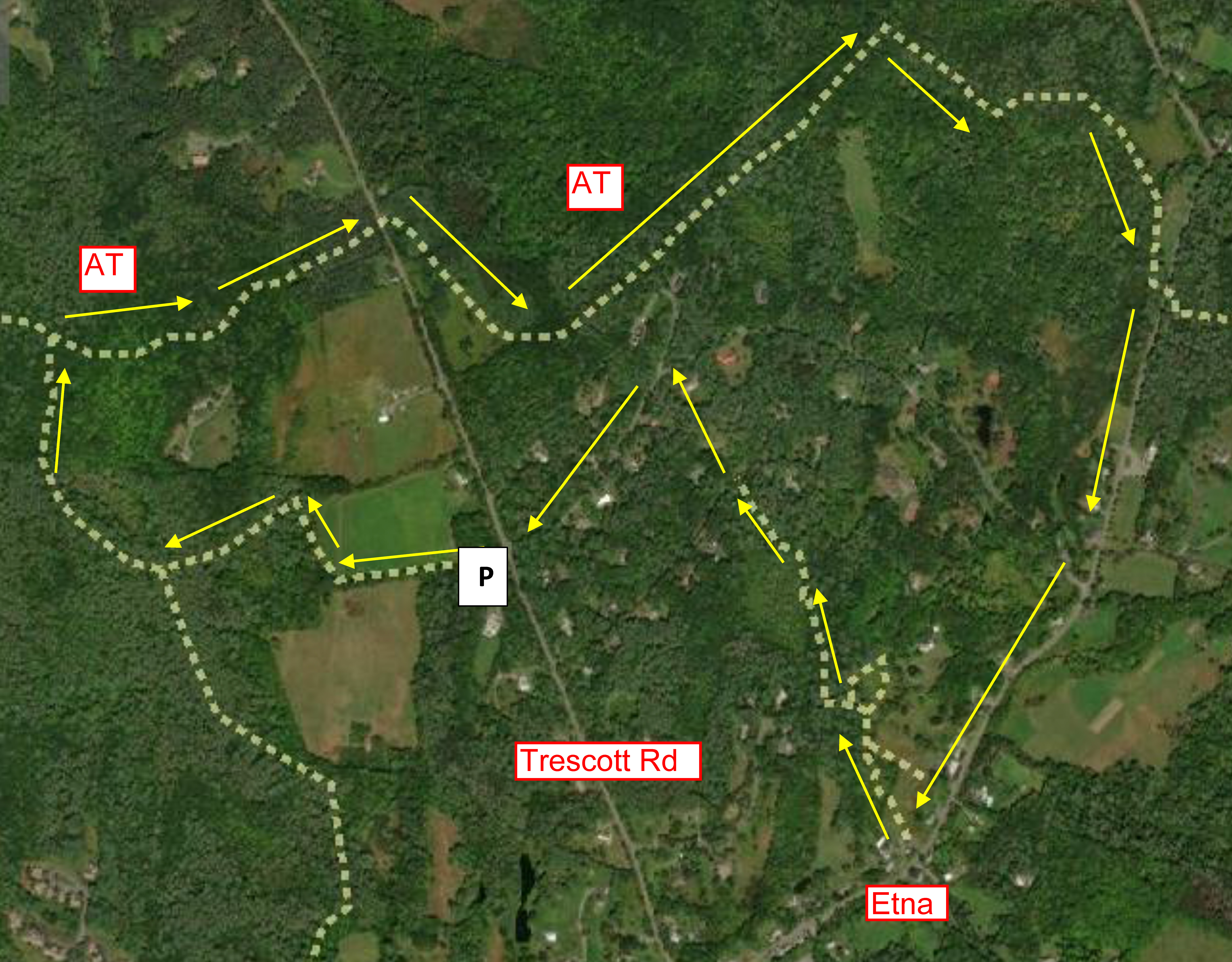
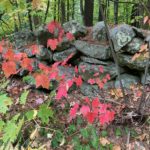 This is a mostly easy hike with a few short steeper sections and some with tricky footing among roots or rocks. The route is well-blazed and signed.
This is a mostly easy hike with a few short steeper sections and some with tricky footing among roots or rocks. The route is well-blazed and signed.BRIEF HIKING DIRECTIONS
FULL DIRECTIONS
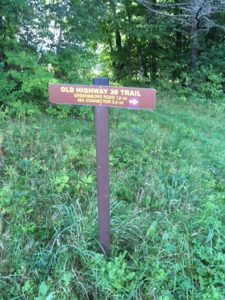 5 minutes’ walk brings you to the top of the rise and a brown/yellow trail sign where two mown paths meet. Look back at R – easily visible is a white 20th century home built as a country retreat by retired architect Archer Hudson. Beyond another hedgerow is the Adams Farm house, a 1790 white cape and home of the family that once owned the former farmland you are exploring now. Hudson purchased land that included the Adams barn – and then burned it down. Dartmouth College later bought the property and carved off his house for resale. While the College referred to it as the “Hudson Farm,” the land ceased to be farmed when Hudson arrived.
5 minutes’ walk brings you to the top of the rise and a brown/yellow trail sign where two mown paths meet. Look back at R – easily visible is a white 20th century home built as a country retreat by retired architect Archer Hudson. Beyond another hedgerow is the Adams Farm house, a 1790 white cape and home of the family that once owned the former farmland you are exploring now. Hudson purchased land that included the Adams barn – and then burned it down. Dartmouth College later bought the property and carved off his house for resale. While the College referred to it as the “Hudson Farm,” the land ceased to be farmed when Hudson arrived.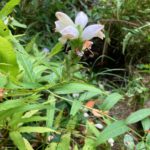 Their bee pollinators must muscle their way inside to gather their nectar.
Their bee pollinators must muscle their way inside to gather their nectar.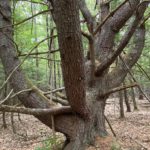 Turn R onto the famed – but here quite humble – Appalachian Trail, heading gently up for 7 minutes to the top of a low ridge. Stop here and note the big old “wolf pine” at L, a pretty impressive character. The growing tip of such a white pine was damaged early in its career, which let side branches develop into competing leaders. No longer valuable for timber, such pines were often left to provide shade for grazing animals – and to spook hikers.
Turn R onto the famed – but here quite humble – Appalachian Trail, heading gently up for 7 minutes to the top of a low ridge. Stop here and note the big old “wolf pine” at L, a pretty impressive character. The growing tip of such a white pine was damaged early in its career, which let side branches develop into competing leaders. No longer valuable for timber, such pines were often left to provide shade for grazing animals – and to spook hikers.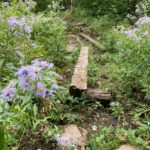 4 minutes later, cross another small wetland decorated with asters and turtlehead.
4 minutes later, cross another small wetland decorated with asters and turtlehead.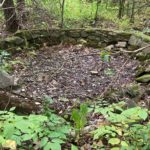
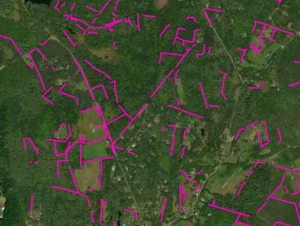 The trail bears L, arriving at an interesting intersection of stone walls that once must have divided pastures. The AT follows one on your L – note some venerable sugar maples lining it. As the trail rises, this wall becomes even more impressive, nearly reaching chest height. We can’t resist sharing here that in 1870, a government agency estimated that over a quarter million miles of drylaid stone wall had been built in New England and New York, most during a few decades in the early 19th century during the Sheep Craze. Recently, NH’s State Geologist has worked with area volunteers and UNH to create a citizen-based, on-line stone wall mapping tool using LiDAR maps. You can visit this site to see the stone walls you’re “collecting” on this hike (shown in pink on the image), and visit your own home area to see what other walls might exist nearby.
The trail bears L, arriving at an interesting intersection of stone walls that once must have divided pastures. The AT follows one on your L – note some venerable sugar maples lining it. As the trail rises, this wall becomes even more impressive, nearly reaching chest height. We can’t resist sharing here that in 1870, a government agency estimated that over a quarter million miles of drylaid stone wall had been built in New England and New York, most during a few decades in the early 19th century during the Sheep Craze. Recently, NH’s State Geologist has worked with area volunteers and UNH to create a citizen-based, on-line stone wall mapping tool using LiDAR maps. You can visit this site to see the stone walls you’re “collecting” on this hike (shown in pink on the image), and visit your own home area to see what other walls might exist nearby. 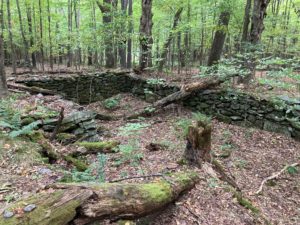
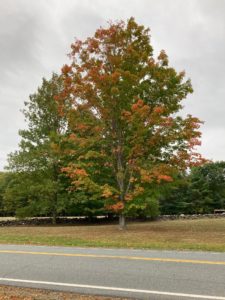 At Ruddsboro Road, a beautiful stone wall (the 13th or 15th?) creates a centuries-old hypotenuse between the roads. This scenic triangle has been protected by the Town of Hanover. It is part of nearby Mink Meadow Farm, home to a long-time Etna farm family. On one side of the historic Yankee-style barn is the foundation of an old silo – on the other, a tiny former milkhouse that now boasts refrigerated eggs and farm-grown vegetables.
At Ruddsboro Road, a beautiful stone wall (the 13th or 15th?) creates a centuries-old hypotenuse between the roads. This scenic triangle has been protected by the Town of Hanover. It is part of nearby Mink Meadow Farm, home to a long-time Etna farm family. On one side of the historic Yankee-style barn is the foundation of an old silo – on the other, a tiny former milkhouse that now boasts refrigerated eggs and farm-grown vegetables. At R is the white 1767 Bridgeman House; the earliest part of this home is likely the middle section with the chimney. Take a moment to read the plaque mounted on the nearby stone. A tributary of Mink Brook passes behind the home and under the road.
At R is the white 1767 Bridgeman House; the earliest part of this home is likely the middle section with the chimney. Take a moment to read the plaque mounted on the nearby stone. A tributary of Mink Brook passes behind the home and under the road. Road. Gifts in her memory allowed the creation of this trail in 2017.
Road. Gifts in her memory allowed the creation of this trail in 2017.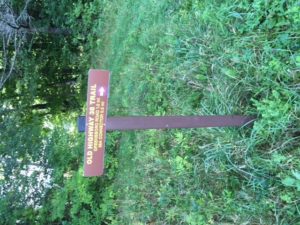 10 minutes from the start of Audrey’s Trail, arrive at Woodcock Lane. Turn R toward the lane’s end and L at a sign just before the driveways. Be sure to keep your dog leashed, and please pick up after it.
10 minutes from the start of Audrey’s Trail, arrive at Woodcock Lane. Turn R toward the lane’s end and L at a sign just before the driveways. Be sure to keep your dog leashed, and please pick up after it.
This Hanover Hike of the Month has been generously sponsored by…
Come explore the lovely world of some of our local butterflies with Bill Shepard at the Etna Library on Monday, August 13th at 3:00.
Look at specimens and learn about moth & butterfly resources before heading outside to the Hayes Farm Park & Nan and Allen King Bird Sanctuary to try your hand at catching a few!
This fun & informative event is recommended for ages 8+, but all are welcome. Event includes a short, easy walk behind the library.
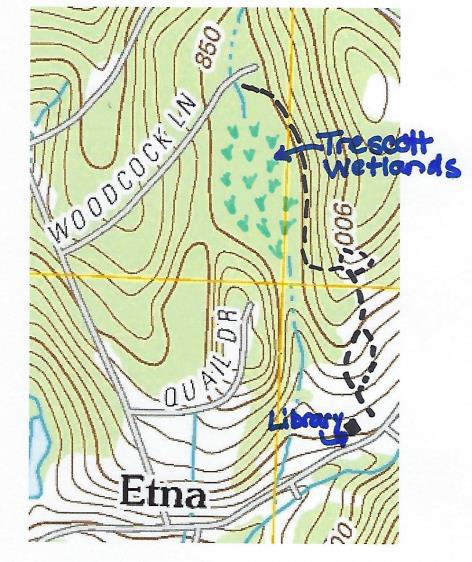 Driving Directions
Driving Directions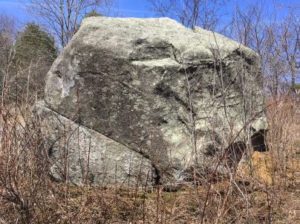 A massive boulder, looking quite out of place, looms ahead. This is a glacial erratic, plucked by the glacier from someplace northwest of here and unceremoniously dropped when the glacier receded, melting around it and leaving it behind. If you look closely, you can see that one H. L. Huntington spent quite a bit of time here on Sept. 14, 1872, carving the erratic’s first (and hopefully only) graffiti.
A massive boulder, looking quite out of place, looms ahead. This is a glacial erratic, plucked by the glacier from someplace northwest of here and unceremoniously dropped when the glacier receded, melting around it and leaving it behind. If you look closely, you can see that one H. L. Huntington spent quite a bit of time here on Sept. 14, 1872, carving the erratic’s first (and hopefully only) graffiti.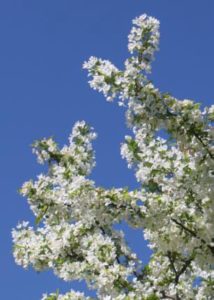
 The Hanover Conservancy and Hanover Conservation Commission partnered to create this sanctuary to honor Nan and Allen King, prominent Hanover conservationists, and to benefit Etna Village. On the Upper Meadow of Hayes Farm Park, the sanctuary features a naturalized planting of hardy native trees and shrubs to benefit wildlife. It was dedicated on June 30, 2011, the Kings’ wedding anniversary. In addition to the Conservancy’s King Memorial Fund, many volunteers and donors helped make the project possible.
The Hanover Conservancy and Hanover Conservation Commission partnered to create this sanctuary to honor Nan and Allen King, prominent Hanover conservationists, and to benefit Etna Village. On the Upper Meadow of Hayes Farm Park, the sanctuary features a naturalized planting of hardy native trees and shrubs to benefit wildlife. It was dedicated on June 30, 2011, the Kings’ wedding anniversary. In addition to the Conservancy’s King Memorial Fund, many volunteers and donors helped make the project possible.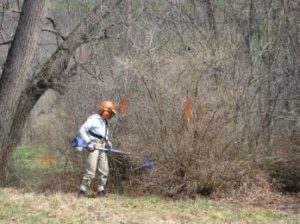
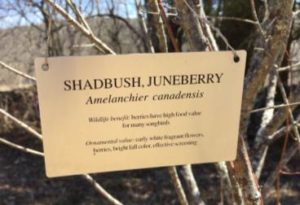 First up in spring are the delicate, fragrant white flowers of shadbush, also called serviceberry and Juneberry. Old-timers associated the blooming of this plant with the spring migration of American shad and also the time for burial services for those who died in winter when the ground was frozen. You’ll find three specimens of this small tree at the King Sanctuary. In June, brightly colored berries follow the flowers, attracting birds. In fall, it sports brilliant foliage.
First up in spring are the delicate, fragrant white flowers of shadbush, also called serviceberry and Juneberry. Old-timers associated the blooming of this plant with the spring migration of American shad and also the time for burial services for those who died in winter when the ground was frozen. You’ll find three specimens of this small tree at the King Sanctuary. In June, brightly colored berries follow the flowers, attracting birds. In fall, it sports brilliant foliage.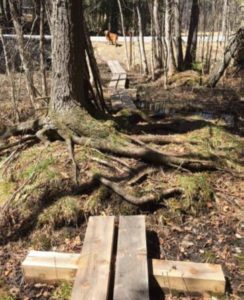
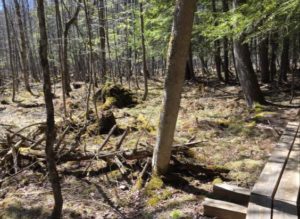 This is a very untidy environment! Mossy stumps, lumps, shrubs, standing and fallen trees create visual havoc but are part of what makes this such a valuable wetland. Note the silence of this place.
This is a very untidy environment! Mossy stumps, lumps, shrubs, standing and fallen trees create visual havoc but are part of what makes this such a valuable wetland. Note the silence of this place.The Conservancy has prepared a map and guide to the King Bird Sanctuary plantings to help visitors learn more about the wildlife benefits and year-round ornamental values of these native plants. Copies are available at the Etna Library and Hanover Town Office.
Sunday 1/24 – join us to explore the Trescott Water Supply Lands with those who are working to open these long-closed 1,165 acres to public recreation. MORE.
Thanks to KLG Financial Solutions for sponsoring this season’s schedule of free Conservancy adventures.
The crabapples are in full bloom, and the bird sanctuary’s new plantings are coming into flower and leaf for their first full season. Jim Block has shared some stunning photos taken at the Sanctuary in the last few days. Find them and more here!